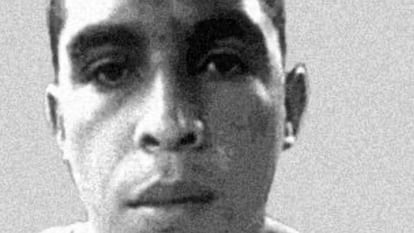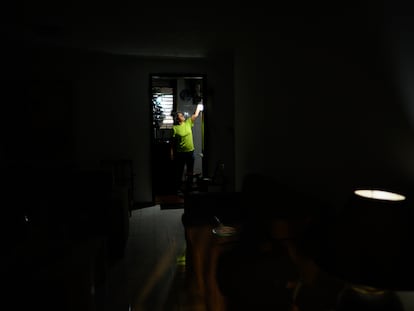El Niño Guerrero, the elusive boss of the Tren de Aragua criminal gang
Héctor Guerrero Flores, who ruled the expanding organization from inside the Tocorón Penitentiary, is nowhere to be found


On August 28, 2012, El Niño Guerrero escaped from Tocorón Penitentiary aided by his brother, brother-in-law, and a few bribed prison guards. It wasn’t a dramatic, movie-style escape. The man known as one of Venezuela’s top three pranes, or prison bosses, walked out the main door at dawn and disappeared into a nondescript city on the Venezuelan plains. Nearly a year later, the police stopped a car with fake license plates carrying four men. During their fingerprint analysis, the police discovered that one man with a fake identification card was actually Guerrero. All these details and more are described in El Tren de Aragua, a recently published book about the criminal gang by Venezuelan journalist Ronna Rísquez.
They recaptured the boss of Tocorón 10 years ago and piled on a few more charges to a rap sheet already full of crimes like drug trafficking and possession of war matériel. But then they returned Guerrero to his prison kingdom, where he continued to manage his criminal enterprise while enjoying ample freedoms and luxuries. He completed his 17-year sentence in late 2022, during which he expanded his organization to several other Venezuelan states and beyond, to Chile, Colombia, Ecuador, Peru, and Brazil. Now everyone is looking for El Niño Guerrero again.
In late September, the Venezuelan government deployed 11,000 troops to take over the prison controlled by Tren de Aragua. When Venezuelan police regained control of Tocorón Penitentiary, they found that Guerrero had served his sentence and left. The Ministry of Interior Relations and Justice released several photographs of the 40-year-old Guerrero, one in which he totes an enormous rifle. “He’s not exactly a fugitive, because Guerrero went in and out of Tocorón whenever he wanted,” Rísquez told EL PAÍS.
Rísquez describes one of El Niño Guerrero’s outings in 2016 during Venezuelas carnaval celebrations (three days before Ash Wednesday). Officials spotted a suspicious party on a large luxury yacht docked at Aragua’s Caribbean coast. The host was Héctor Guerrero Flores, who presented a document from the Ministry of Penitentiary Services that authorized his travel throughout the country. The police officers reported this to their superiors and were instructed to leave the premises. Except for that one incident, Rísquez says Guerrero usually kept a very low profile. “Everyone in Venezuela knew he was the one calling the shots. But when officials in other countries started rounding up members of his crew and found phone and text messages from him, that’s when El Niño Guerrero and Tren de Aragua started becoming known in the region.”
Rísquez says the other two bosses of Tren de Aragua are both 45 years old and also at large. All three bosses were presumed dead after a 2015 police raid near Valencia, Venezuela’s third-largest city. Years later, the world learned that the boss known as Larry Changa (Larry Amaury Álvarez Núñez) made it to Santiago, Chile, by plane in 2018 and disguised himself as a food truck vendor in the heart of Chile’s capital. The Chilean police began tracking him in 2021 after connecting him to a homicide case involving the sale of a vehicle that he owned.
One of the ways Tren de Aragua made money was by using Facebook Marketplace to lure people interested in buying cheap cars. Unfortunately, when the buyers arrived to buy the car, they were robbed and sometimes murdered. In March 2022, the Tren de Aragua members in Chile vanished without a trace after Venezuelan authorities failed to provide any information to aid in the investigations. According to testimony in Rísquez’s book, they presumably entered the United States through its southern border. Another Tren de Aragua member, Johan José Romero (aka Johan Petrica), was identified in Brazil last year when he tried to register his Brazilian-born four-year-old son. It is now rumored that he lives in southern Venezuela and heads Tren de Aragua’s illegal gold mining business in Las Claritas.
A kingdom demolished
El Niño Guerrero, who the police dubbed “Tocorón’s No.1,″ built a city in the prison that he controlled until recently. Rísquez once entered the prison and confirmed the long-standing complaints about the luxuries and privileges enjoyed by the prisoners. According to the independent Venezuelan Prisons Observatory, eight of the nearly 50 prisons in the country are controlled by criminal gangs. These prisons hold almost half of the country’s inmates. Another 15 prisons have a mixed regime, with some sectors controlled by the authorities and others by the gangs. The Venezuelan Prisons Observatory recently questioned the government’s easy takeover of Tocorón, in light of the fierce battles it waged to regain control of six smaller prisons.
In her book, Rísquez described Tocorón Penitentiary as a fantasy theme park, complete with a swimming pool, nightclub, zoo with a rare, albino peacock, prisoners living in comfort with their entire families, fancy restaurants, booths for inmates to pay “rent” to the gang, powerful motorcycles, tour guides, a baseball stadium, and special armed guards for the boss. Tocorón had stores claiming to offer clothing from luxury brands like Balenciaga or Gucci, as well as others selling cocaine and crack. There was a marked distinction between lower-class inmates who never had visitors or who were seriously ill, and the true believers who had been “baptized” into Tren de Aragua.
During the prison raid, authorities discovered 14 long rifles and two short rifles, 40 anti-tank grenades, 80 kilos of C4 explosive, 400,000 rounds of ammunition, 15 rocket-propelled grenade launchers and other war matériel. They also discovered a tunnel network underneath the facility. On September 23, bulldozers began demolishing everything that El Niño Guerrero had built in Tocorón Penitentiary.
Minister Remigio Ceballos appeared on television during the demolition and gave his second assessment of the raid that seized control of one of the country’s most violent prisons in a matter of hours. He stressed the careful planning that went into the raid and denied that terms had been negotiated with Tren de Aragua. Ceballos stated that 1,600 inmates were relocated to other prisons, while Tocorón, built in 1982 to house 750 inmates, would be remodeled. He reported the arrest of 88 gang members who were providing information about the leaders, who he said have committed “atrocities as part of a destabilizing conspiracy strategy by violent opposition groups to achieve their political goals.”
By seizing Tocorón and dismantling other criminal gangs, the Venezuelan government seems to be intent on improving public safety amid high levels of violence and insecurity. Nevertheless, allegations have surfaced of political influence over security operations that seek to link organized crime to the country’s political opposition. Meanwhile, El Niño Guerrero and his associates are still at large, mocking the claim by Ceballos that the “former Tren de Aragua has been completely destroyed.”
Sign up for our weekly newsletter to get more English-language news coverage from EL PAÍS USA Edition
Tu suscripción se está usando en otro dispositivo
¿Quieres añadir otro usuario a tu suscripción?
Si continúas leyendo en este dispositivo, no se podrá leer en el otro.
FlechaTu suscripción se está usando en otro dispositivo y solo puedes acceder a EL PAÍS desde un dispositivo a la vez.
Si quieres compartir tu cuenta, cambia tu suscripción a la modalidad Premium, así podrás añadir otro usuario. Cada uno accederá con su propia cuenta de email, lo que os permitirá personalizar vuestra experiencia en EL PAÍS.
¿Tienes una suscripción de empresa? Accede aquí para contratar más cuentas.
En el caso de no saber quién está usando tu cuenta, te recomendamos cambiar tu contraseña aquí.
Si decides continuar compartiendo tu cuenta, este mensaje se mostrará en tu dispositivo y en el de la otra persona que está usando tu cuenta de forma indefinida, afectando a tu experiencia de lectura. Puedes consultar aquí los términos y condiciones de la suscripción digital.
More information
Archived In
Últimas noticias
‘I thought you would like it’: The risky sexual practice popularized by TV shows and TikTok
The digitalization of tourism: ‘They promise experiences and gave us the worst possible one’
Mexican peso defies uncertainty with forecasts of a new period of stability in 2026
Meghan Markle’s year of redemption: Numerous projects, some setbacks and a brand that is finally taking off
Most viewed
- Sinaloa Cartel war is taking its toll on Los Chapitos
- Oona Chaplin: ‘I told James Cameron that I was living in a treehouse and starting a permaculture project with a friend’
- Reinhard Genzel, Nobel laureate in physics: ‘One-minute videos will never give you the truth’
- Why the price of coffee has skyrocketed: from Brazilian plantations to specialty coffee houses
- Silver prices are going crazy: This is what’s fueling the rally










































